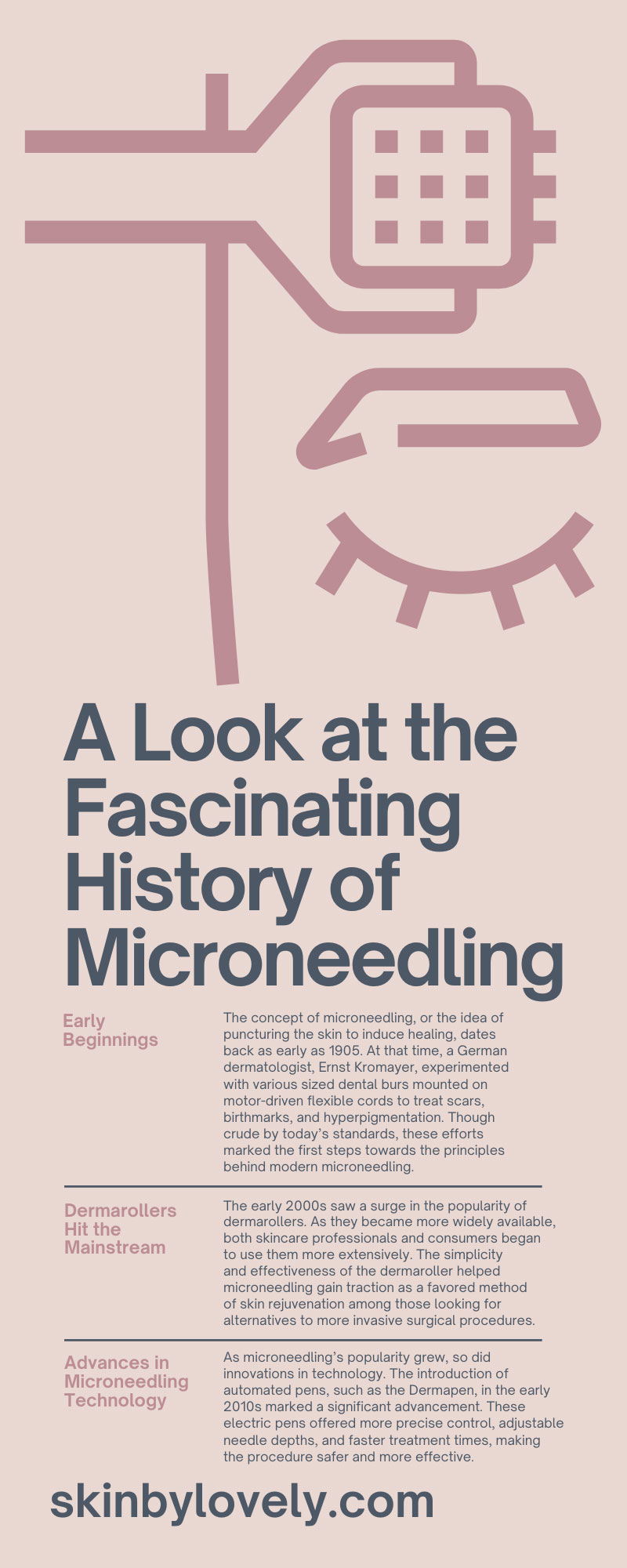Camas, WA
Injectables
Skin Rejuvenation
Hair Restoration & Growth
Shop By Category

Microneedling, a popular cosmetic procedure known for its effectiveness in treating various skin conditions, has a history as intriguing as the results it delivers. This minimally invasive treatment has evolved significantly over the years, incorporating advanced technology and refined techniques to become a staple in cosmetic skincare. Here’s a look at the fascinating history of microneedling.
The concept of microneedling, or the idea of puncturing the skin to induce healing, dates back as early as 1905. At that time, a German dermatologist, Ernst Kromayer, experimented with various sized dental burs mounted on motor-driven flexible cords to treat scars, birthmarks, and hyperpigmentation. Though crude by today’s standards, these efforts marked the first steps towards the principles behind modern microneedling.
Microneedling devices began to evolve in the 1950s with the development of motorized tattoo guns, which were noticed to improve the appearance of scars when pigment wasn’t used. Dermatologists started experimenting with these devices, noting that the needles alone could promote collagen production without the need for ink, leading to improvements in skin texture and firmness.
The first official microneedling tool was introduced in the late 1990s by a South African plastic surgeon, Dr. Desmond Fernandes. He developed a cylindrical drum studded with fine needles, known today as the dermaroller. Dr. Fernandes used this tool primarily to treat wrinkles and scars, fundamentally shaping the future of non-invasive skin therapies.
The early 2000s saw a surge in the popularity of dermarollers. As they became more widely available, both skincare professionals and consumers began to use them more extensively. The simplicity and effectiveness of the dermaroller helped microneedling gain traction as a favored method of skin rejuvenation among those looking for alternatives to more invasive surgical procedures.
In the mid-2000s, numerous scientific studies began to emerge, backing the efficacy of microneedling. Research demonstrated significant improvements in skin conditions like acne scars, fine lines, and overall skin texture. These studies helped propel microneedling from a niche treatment to a well-recognized skin rejuvenation method supported by solid scientific evidence.
As microneedling’s popularity grew, so did innovations in technology. The introduction of automated pens, such as the Dermapen, in the early 2010s marked a significant advancement. These electric pens offered more precise control, adjustable needle depths, and faster treatment times, making the procedure safer and more effective.
The combination of microneedling with platelet-rich plasma (PRP) therapy started around the 2010s, enhancing the healing process. PRP involves using a portion of the patient’s own blood, enriched with platelets, to promote cellular repair and regeneration. When used with microneedling, PRP was found to accelerate the healing process and improve results, particularly in anti-aging and scar treatment.
As its effectiveness became more widely known, the scope of microneedling expanded beyond facial rejuvenation. Today, the method is used to treat various areas of the body, including the scalp for hair growth stimulation and the chest and neck areas for skin tightening and wrinkle reduction.
One of the key benefits of microneedling that has been realized over time is its suitability for almost all skin types. Unlike certain laser treatments which can pose risks for darker skin tones, microneedling does not involve heat, which minimizes the risk of hyperpigmentation, making it a safer option for everyone.
The development of at-home microneedling devices has made the treatment more accessible. While these devices are generally less powerful than the professional ones used in clinics, they still offer individuals the opportunity to maintain their skin condition between professional treatments. However, it’s important to use these devices correctly to avoid potential skin damage.
Microneedling’s versatility allows it to be effectively combined with various other skincare therapies to enhance results. Integrating radiofrequency (RF) with microneedling, for example, has proven effective in tightening the skin by stimulating deeper collagen production.
Additionally, applying therapeutic serums immediately after microneedling takes advantage of the microchannels created during the treatment, enhancing the absorption and efficacy of these products. This combination therapy approach not only maximizes the benefits of each treatment but also addresses multiple skin concerns simultaneously, such as elasticity, hydration, and overall skin texture improvement.
As microneedling has grown in popularity, so has the importance of proper training and certification for practitioners. This ensures those performing the treatments are equipped with the knowledge and skills to do so safely and effectively.
From the latest devices and techniques to navigating skin types and client expectations, training programs equip you with everything you need to deliver effective treatments and manage potential side effects. Plus, the certification you receive from these programs reassures patients that they are receiving care from a qualified professional, maintaining high standards within the industry.
The regulation of microneedling treatments and devices has become increasingly stringent to ensure patient safety and treatment efficacy. In the United States, the FDA classifies microneedling devices based on their intended use, whether they involve an energy source, and the depth they penetrate into the skin.
These regulations help prevent the sale and use of low-quality devices that could potentially harm users. Additionally, practitioners are expected to adhere to strict hygiene and safety protocols to minimize risks such as infections and scarring.
The future of microneedling treatment looks bright with ongoing innovations and research. Scientists are exploring ways to use microneedling for transdermal drug delivery, including potential applications in vaccine administration.
This could open new avenues for administering medications and vaccines, using microneedling’s ability to bypass the skin’s outer barrier without significant discomfort or the need for more invasive procedures. With these developments, microneedling could extend beyond cosmetic applications to become a valuable medical tool.
Microneedling has significantly influenced modern skincare trends, emphasizing the importance of collagen induction therapies for anti-aging and skin rejuvenation. Its ability to deliver visible improvements in skin texture and firmness with minimal downtime has made it a preferred option over more invasive procedures like laser treatments or chemical peels. As consumer demand for effective and non-invasive treatments grows, microneedling continues to be at the forefront of cosmetic innovation, shaping future skincare trends.
Now that you know about the fascinating history of microneedling, you can appreciate how far this treatment has come and why it’s considered a pivotal part of modern dermatological care. As technology advances, microneedling will undoubtedly continue to play a key role in cosmetic and therapeutic dermatology.
